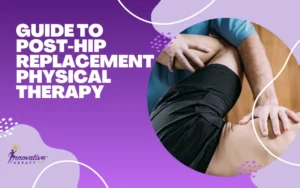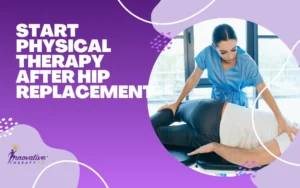Are you tired of tech neck from endless scrolling? Discover how physical therapy for neck pain can save your posture! In this guide, we’ll uncover simple yet effective exercises tailored for smartphone users.
Say goodbye to stiffness and discomfort as we delve into strategies to combat the digital slump.
From easy stretches to ergonomic tips, we’ve got your back – or rather, your neck! So, if you’re ready to reclaim your mobility and banish smartphone-induced pain, let’s dive in together. Your neck will thank you later!
What Causes Neck Pain?
Unraveling The Complex Tapestry Of Neck Pain Origins

Neck pain, a prevalent affliction in the modern era, weaves a complex tapestry of causative factors. Understanding these roots is paramount to tailoring effective physical therapy interventions.
From the seemingly innocuous actions of prolonged screen time to the intricate dance of muscle strains, various elements contribute to the onset of neck discomfort.
Prolonged Screen Time And Technological Strain
In an age dominated by screens, be it computers, smartphones, or tablets, the neck often bears the brunt of our technological immersion. Hours spent hunched over devices create a perfect storm for muscle tension and stiffness. The neck, a delicate balance of bones, muscles, and ligaments, succumbs to the strain, setting the stage for discomfort.
Stress-Induced Muscular Tension
The mind-body connection intricately influences our physical well-being. Stress, a ubiquitous companion in our hectic lives, manifests physically, often manifesting in tightened muscles.
The neck, with its web of interconnected muscles, becomes a prime target for this tension—the result: a painful reminder of the intricate dance between mental and physical health.
Awkward Sleeping Positions And Muscular Misalignment
The rejuvenation of sleep becomes a potential minefield for neck pain. Unconscious shifts in posture during sleep, coupled with unsupportive pillows or mattresses, can lead to awkward positions.
Muscles may wake up in misaligned disarray, contributing to morning neck discomfort. The restorative power of sleep paradoxically becomes a source of physical strain.
The Cumulative Impact Of Lifestyle Choices
Our lifestyle dramatically affects neck pain. Being inactive, not exercising regularly, and practising poor ergonomics all add up and harm neck health. The neck is built for movement, so when we lead sedentary lives, it protests with pain.
What Are Some Symptoms Of Neck Pain?
Navigating The Multifaceted Landscape Of Neck Pain Symptoms
Neck pain isn’t just a single, isolated feeling; it affects various aspects of daily life in multiple ways. Recognizing these symptoms goes beyond acknowledging simple discomfort; it’s the initial step toward targeted physical therapy interventions.
Stiffness: The Silent Restriction
Stiffness, a silent and persistent companion of neck pain, manifests as a gradual restriction in the range of motion. Simple actions like turning the head become laborious tasks, unveiling the pervasive nature of neck discomfort.
Headaches: The Unwelcome Residue
Neck pain often leaves behind an unwelcome residue in the form of headaches. The interconnected network of nerves and blood vessels in the neck intricately ties into the head, creating a pathway for pain to radiate. Headaches become a tangible reminder of the interplay between neck and cranial health.
Radiating Pain: A Journey Down the Arms
Neck pain extends its reach, manifesting as radiating discomfort down the arms. This phenomenon, known as radiculopathy, occurs when nerves in the neck are compressed or irritated.
The result is a tingling or numbing sensation, accentuating the systemic impact of neck pain beyond its focal point.
Emotional Impact: The Unseen Burden
Neck pain isn’t confined to the physical realm; it casts a shadow on emotional well-being. The chronic nature of neck discomfort can contribute to stress, anxiety, and even depression. Understanding and addressing the emotional burden becomes integral to comprehensive physical therapy strategies.
3 Ways Physical Therapy For Neck Pain Can Transform Your Well-being

Unlocking the Potential: A Holistic Approach to Neck Pain Relief
Physical therapy stands out as a source of hope for neck pain, providing a comprehensive approach that goes beyond just managing symptoms. Let’s delve into three key ways through which physical therapy can lead to a transformative journey in easing neck discomfort.
Improve Range of Motion: Liberating the Neck’s Potential
In physical therapy, a key goal is to overcome stiffness and limited movement often associated with neck pain. Therapists use specific exercises to tackle these range of motion restrictions systematically.
With gentle stretches, rotational exercises, and dynamic movements, individuals gradually regain the ability to turn their heads more easily. In physical therapy, the journey is personalized to suit each person’s specific needs and comfort levels. As the range of motion gets better, stiffness fades away, bringing a newfound freedom that makes daily activities easier.
Whether it’s checking blind spots while driving or turning your head without pain, the progress in movement becomes a clear sign of how well physical therapy is working.
Strengthen Postural Flexibility: Building A Foundation of Resilience
Lousy posture can quietly add to neck pain, creating a cycle where discomfort leads to more misalignment. Physical therapy focuses on this issue by strengthening the muscles that help maintain good posture. Specific exercises target the muscles in the neck, shoulders, and upper back, improving their endurance and flexibility.
Physical therapy works to establish a strong foundation of postural flexibility by combining strengthening exercises, postural corrections, and targeted muscle activation.
As muscles become stronger, they naturally stabilize, easing the strain on the neck during daily activities. This not only relieves current pain but also serves as a preventive measure against future discomfort. It empowers individuals to maintain a pain-free and upright posture.
Education: Empowering Through Knowledge
In physical therapy, education is just as important as the hands-on treatment. Therapists teach people about how the neck works, proper ergonomic practices, and exercises that fit their needs.
This educational part goes beyond the therapy sessions, making individuals feel more involved and confident in their recovery. In essence, physical therapy for neck pain extends far beyond the conventional view of treatment. It is a holistic and empowering process that not only addresses immediate symptoms but seeks to enhance overall neck health.
By enhancing the range of motion, strengthening postural flexibility, and providing valuable education, physical therapy becomes a driving force for a deep and lasting change in the way neck pain is experienced.
How Long Is Physical Therapy for Neck Pain?
Navigating The Temporal Landscape Of Neck Pain Recovery
The length of physical therapy for neck pain can vary a lot, depending on many factors, like how bad the condition is and how well someone responds to treatment.
Knowing this helps set realistic expectations and shows how much commitment is needed for a full recovery.
Individual Variability: No One-Size-Fits-All Timeline
Just like everyone’s neck pain is different, the path to recovery with physical therapy is also unique. There’s no one-size-fits-all timeline for how long the treatment will take.
Things like the reasons behind the neck pain, other health issues, and the person’s overall health all play significant roles in deciding how long physical therapy will last.
Severity of Neck Pain: A Determining Factor
How long you need physical therapy depends a lot on how bad your neck pain is. If it’s something recent and not too severe, you might feel better in a short time.
But if it’s been bothering you for a while or it’s more complicated, the therapy might take longer and be more comprehensive.
Response to Treatment: A Variable Factor
People respond differently to physical therapy, adding another layer of variability. Some may see quick improvements, experiencing relief within a few weeks. For others, progress might be slower, with benefits accumulating gradually over an extended period.
Collaborative Goal-Setting: A Shared Endeavor
How long physical therapy lasts is often determined by the goals set together by the person and the therapist. Creating goals that are realistic and attainable helps keep the focus on improving functionality and overall well-being. Regularly reassessing these goals makes the therapeutic process adaptable to the individual’s needs.
When Physical Therapy May Be Recommended
Navigating The Decision-Making Landscape
Deciding on physical therapy for neck pain involves carefully looking at many different factors. Knowing when it might be recommended gives us a better idea of how decisions are made and what factors play a role in choosing this treatment method.
Persistent or Recurrent Pain: A Signaling Factor
If neck pain sticks around or keeps coming back for a long time, it’s a sign that physical therapy might be necessary. Persistent discomfort could point to underlying problems that need specific treatments. Even if the pain goes away temporarily but keeps coming back, it indicates a need for thorough strategies to prevent it from happening again.
Impaired Functionality: Hindrance To Daily Activities
If neck pain is affecting your ability to do everyday tasks, like turning your head or doing work-related activities, physical therapy might be suggested. When daily activities become challenging, targeted interventions are needed to improve function. The aim is to boost your ability to go about your daily life without any obstacles.
Limited Range Of Motion: Restriction In Movement
If you notice your neck movement is limited, it’s a good reason to think about physical therapy. Whether it’s a slight or noticeable restriction, it’s a chance to work on stiffness and enhance flexibility with specific exercises and hands-on therapy. The main goal is to get your neck moving freely again.
Diagnosis Of Musculoskeletal Issues: Identifying Underlying Causes
When musculoskeletal problems like cervical disc disease or muscle imbalances are diagnosed, physical therapy is commonly advised.
Knowing what’s causing the neck pain is critical to figuring out the best treatments. Physical therapy is vital for targeting these specific issues and helping the body heal.
Collaborative Decision-Making: Informed Choices
Deciding on physical therapy for neck pain usually involves teamwork between healthcare experts and the person with pain. A careful look at the person’s medical history, symptoms, and daily habits helps make intelligent decisions. Keeping the conversation open ensures the recommendation matches the person’s goals and choices.
When to Avoid Physical Therapy for Neck Pain

Navigating the Limitations: Instances of Caution
Physical therapy is valuable for neck pain, but its application requires careful consideration. Knowing when to avoid it involves recognizing specific scenarios where alternative approaches or additional assessments may be more appropriate.
Severe Neurological Symptoms: Red Flags
If you experience severe neurological symptoms like sudden weakness, numbness, or coordination loss in your arms or hands, seek medical help promptly.
The initial focus should be on medical evaluation, including imaging and neurological assessments, to rule out severe conditions.
Physical therapy may be postponed until these issues are addressed. Once the neurological concerns are managed, physical therapy can be part of your comprehensive care plan.
Unstable Fractures Or Dislocations: Stabilization First
When dealing with unstable fractures or dislocations in the cervical spine, stabilization takes precedence over immediate physical therapy. Surgical intervention or other stabilization measures may be necessary before starting rehabilitative exercises. The primary goal is to ensure the structural integrity of the spine before moving on to therapeutic interventions.
Severe Osteoporosis: Fragility Considerations
Severe osteoporosis, marked by bone density loss and fragility, requires caution in physical therapy. High-impact exercises or manipulations could risk fractures. Instead, low-impact activities and modified exercises are safer and closely monitored by healthcare providers.
Physical Therapy Treatment Methods
Unveiling the Toolkit: Diverse Strategies for Neck Pain Relief
Physical therapy for neck pain offers a range of treatments, each chosen to suit the individual’s needs. These diverse methods include exercises, manual therapy, ergonomic adjustments, and more. Knowing about these treatments shows how physical therapists use various tools to help people find relief from neck pain.
Manual Therapy: Hands-On Intervention
Hands-on techniques, known as manual therapy, are crucial in treating neck pain through physical therapy. Therapists use methods like massage, joint mobilization, and stretching to ease muscle tension, boost flexibility, and improve joint mobility. The hands-on approach lets therapists precisely target individual needs for more effective intervention.
Therapeutic Exercises: Tailored to Individual Needs
Therapeutic exercises are essential in physical therapy for neck pain, targeting specific issues and improving overall neck function. They consist of stretching, strengthening, and stabilization exercises personalized to the individual’s needs. The exercises evolve based on the individual’s progress, focusing on enhancing range of motion, building muscle support, and promoting resilience.
Modalities: Temperature-Based Interventions
Modalities such as heat or cold therapy are employed to complement other interventions in physical therapy. Heat can be used to relax muscles and improve blood flow, while cold therapy may help reduce inflammation and numb localized pain. The strategic application of these modalities contributes to pain relief and facilitates a more comfortable environment for therapeutic interventions.
Postural Education: Enhancing Alignment
Improving posture is a critical focus in physical therapy for neck pain. Therapists provide education on optimal ergonomics, body mechanics, and postural awareness.
This knowledge empowers individuals to make conscious adjustments in daily activities to promote better alignment and reduce strain on the neck. Postural education is a proactive strategy aimed at preventing the recurrence of pain.
Ergonomic Guidance: Tailoring the Environment
Physical therapists provide advice on ergonomic changes at work and home to reduce neck strain. This involves suggestions for desk and chair height, monitor placement, and supportive pillows. Ergonomic guidance goes beyond the clinic, fostering an environment that supports neck health.
Traction: Mechanical Intervention
Neck traction gently pulls the neck, aiming to create space between vertebrae and relieve nerve pressure. It can be done manually by a therapist or with mechanical devices. Traction is customized for cases needing spine decompression, like some disc-related issues.
Patient Education: Empowering Through Knowledge
Patient education is a crucial part of physical therapy, empowering individuals to comprehend their condition and play an active role in their recovery.
Therapists share insights about anatomy, the mechanics of neck pain, and self-management strategies. This knowledge fosters a sense of autonomy, providing individuals with the tools to make informed choices for long-term neck health.
Post-Operative Rehabilitation: Guiding Recovery
After neck surgery, physical therapy becomes vital for post-operative rehabilitation. Therapists lead individuals through specific exercises, mobility drills, and gradual progressions to regain function and ensure a safe recovery. The goal is to optimize outcomes and improve the individual’s quality of life.
5 Ways to Relieve Your Neck Pain, from a PT

Neck pain can be a persistent companion, but with the guidance of a physical therapist, relief is within reach. Here are five expert-backed strategies to alleviate neck pain and promote overall musculoskeletal well-being.
Look All Around The Room
Enhancing Neck Mobility with Gentle Rotation
One effective way to relieve neck pain is by incorporating gentle neck rotations into your routine. Sit or stand comfortably, and slowly turn your head to one side, aiming to look as far as you can without straining. Hold the position for a few seconds, feeling a mild stretch, and then repeat on the other side. This simple exercise helps improve neck mobility, reduces stiffness, and can be easily integrated into your daily activities.
Move a Little Every Hour
Combatting Stagnation For Neck Health
In our sedentary lifestyles, the neck can bear the brunt of prolonged periods of stillness. Combat this by making a conscious effort to move a little every hour. Whether it’s standing up, stretching, or taking a short walk, these intermittent movements prevent muscles from becoming overly tight and contribute to improved circulation. Break the monotony of sitting to keep your neck and spine happy throughout the day.
Do The Chin Tuck
Strengthening And Aligning Neck Muscles
The chin tuck is a simple yet powerful exercise to strengthen and align the muscles in your neck.
While sitting or standing with a straight back, gently tuck your chin towards your chest without tilting your head.
Hold the position for a few seconds, feeling a gentle stretch at the back of your neck. This exercise helps improve posture, strengthens neck muscles, and reduces strain on the cervical spine.
Improve Your Form at the Gym
Preventing Neck Strain During Workouts
Proper form during gym workouts is crucial for preventing neck strain. Whether lifting weights, doing cardio, or engaging in any physical activity, pay attention to your form. Avoid hunching shoulders, especially during resistance exercises, and ensure that your spine remains aligned.
Take A Child’s Pose
Yoga For Neck Pain Relief and Relaxation
The Child’s Pose, a yoga posture, can be an excellent way to release tension and provide relief for your neck. Start on your hands and knees, then sit back on your heels, reaching your arms forward on the floor.
Allow your forehead to rest on the ground, stretching your neck and upper back. This posture helps elongate the spine, relax neck muscles, and can be a soothing addition to your routine.
Follow these expert-recommended tips in your daily routine to ease neck pain and boost your overall musculoskeletal health. For personalized guidance based on your needs, consult with a physical therapist.
FAQ More About Physical Therapy For Neck Pain
What will A Physical Therapist Do For My Neck?
Physical therapists use a mix of methods, like hands-on therapy, specific exercises, and education. The main aim is to ease pain, boost mobility, and encourage individuals to be actively involved in their recovery. This underscores the importance of a personalized and all-encompassing approach.
How Long Does Physical Therapy Take To Work On The Neck?
The length of physical therapy changes based on factors like how severe the condition is and how well someone responds to treatment. Sticking to the recommended exercises and actively taking part dramatically speeds up recovery, showing how important it is to stay committed to the therapy.
Which Therapy Is Best For Neck Pain?
Physical therapy is commonly the first choice for treating neck pain because it effectively tackles root problems and lowers the chance of it coming back. Yet, the exact method can differ depending on personal needs, showing how healthcare choices are tailored to each person.
How Do You Rehab Your Neck?
Rehabilitating the neck involves a multifaceted approach, including targeted exercises, manual therapy, and lifestyle adjustments. A physical therapist guides individuals through a personalized rehabilitation plan tailored to their unique condition, emphasizing the collaborative and empowering nature of the rehabilitation process.
How Do Older People Strengthen Their Necks?
Seniors can enhance neck strength with gentle exercises suggested by a physical therapist. Engage in neck stretches, isometric exercises, and movements that improve flexibility and strength. This highlights the significance of personalized interventions that take age-related factors into account.
What Exercises Should I Avoid With Neck Pain?
It’s essential to steer clear of exercises that worsen neck pain or strain. Consulting with a physical therapist is critical to pinpointing movements to avoid and getting advice on safe, targeted exercises for your condition. The focus is on crafting a personalized exercise plan that fosters healing without risking additional harm.
How Effective Is Physical Therapy For Neck Pain?
Physical therapy for neck pain is highly effective in reducing pain, improving range of motion, and restoring function in the neck area. It involves targeted exercises, manual therapy techniques, and education to address underlying issues contributing to neck pain.
What Does Physical Therapy For Neck Pain Entail?
Physical therapy for neck pain typically includes a combination of exercises to strengthen and stretch neck muscles, manual therapy techniques such as massage or joint mobilization, posture correction, and ergonomic recommendations to alleviate discomfort and improve function.
Can Physical Therapy Help With A Stiff Neck?
Yes, physical therapy is instrumental in addressing a stiff neck. Through specific exercises, gentle stretching, and manual therapy techniques, physical therapists can help reduce stiffness, improve flexibility, and restore standard movement patterns in the neck.
How Soon Can I Expect To See Results From Physical Therapy For Neck Pain?
The timeline for seeing results from physical therapy for neck pain varies depending on the severity of the condition and individual factors. Some people experience relief after a few sessions, while others may require more time and consistent effort to achieve significant improvement.
Are There Specific Exercises Recommended For Physical Therapy For Neck Pain?
Yes, physical therapy for neck pain often includes exercises to strengthen neck muscles, improve posture, and increase flexibility. Examples may consist of neck stretches, cervical spine stabilization exercises, and range of motion exercises tailored to your specific needs.
What Role Does Physical Therapy Play In Managing Chronic Neck Pain?
Physical therapy plays a crucial role in managing chronic neck pain by addressing underlying muscle imbalances, promoting proper posture and alignment, and teaching strategies for pain management and prevention. It empowers individuals to take an active role in their recovery and long-term well-being.
Is Physical Therapy A Suitable Treatment Option For All Types Of Neck Pain?
Physical therapy is a versatile treatment option that can be tailored to address various types of neck pain, including acute injuries, chronic conditions, and postural issues. A skilled physical therapist can assess your specific condition and develop a personalized treatment plan to meet your needs.
How Can I Find A Qualified Physical Therapist For Neck Pain Treatment?
To find a qualified physical therapist for neck pain treatment, you can ask for recommendations from your healthcare provider, check online directories, or inquire at local physical therapy clinics. Look for therapists with experience and expertise in treating neck pain to ensure you receive quality care.
Conclusion
Embarking on the path of physical therapy for neck pain is like a journey that transforms your well-being. It’s not just about managing symptoms; it’s about improving your overall musculoskeletal health in a lasting way. With tailored treatments, helpful education, and a team effort, physical therapy becomes a guiding light for healing. It empowers you to control your neck health, leading to a future without ongoing discomfort.





